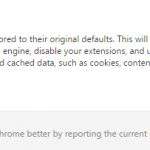Google Chrome and other Chromium based web browser such as new Microsoft Edge Chromium supports configuration of policies when the web browser is used at work or school or on enterprise environment. In other words, your company, your school or other organization who set up or maintain your Chrome or Edge web browser can manage the web browser by implementing various policies to control how you use the browser, changing the browser setup, restricting certain features, installing extensions, and monitoring activity remotely.
If you’re using a company or school issued computer, it’s understandable that the Chrome or Edge or other Chromium-based web browser is managed by the organization through Active Directory Group Policy, Intune or G Suite. However, what if you’re using the computer at home for personal use only and the web browser wrongly states that it’s managed by your organization in the menu?
The reason why Chrome or Edge can be managed by an organization is the use of policies. It does not matter how the policies are deployed, whether by organization or by yourself. You may unknowingly install a policy to Chrome or Edge to authorize extensions when installing unauthorized or unsanctioned extensions and add-ons (not installed through official stores), or some software applications, especially security software such as antivirus and freeware bundled with adware, and to the lesser extent malware or browser hijackers, may install policies to your web browser, such as to force the use of their search engine, enforce security policies, or to install malicious add-ons or extensions.

You can verify if the Chrome or Edge is managed by opening up the menu, and if your browser is managed, “Managed by your organization” is shown at the end of the menu.
To double confirm the managed browser and to check for more details, such as to check the extensions that your organization set up on your browser, browse to the following URL:
Chrome: chrome://management
Edge: edge://management

Most of the time your browser is managed not because of addition of compulsory extensions, but because of various policies applied. You can find out what policies are applied to the Chrome or Edge by entering the following URL in address bar:
Chrome: chrome://policy
Edge: edge://policy
Now the big question. How to stop the Chrome or Edge of being managed by your organization, especially if it’s on personal computer? The “Policies” page only shows you the various policies that are enforced on the browser, but there is no way to remove them, so that your browser is “unmanaged”.
On Windows, Chrome saves all the browser’s policies in HKEY_LOCAL_MACHINE\SOFTWARE\Policies\Google\Chrome registry key; while Edge saves all the browser’s policies in HKEY_LOCAL_MACHINE\SOFTWARE\Policies\Microsoft\Edge.
So the easiest method to free your Chrome and Edge from “being managed by your organization” is by deleting all sub-keys and their values within the above registry key.
On macOS or Mac OS X, the web browsers are managed through profiles. To remove unwanted profiles or malicious profiles, follow these steps:
- Go to System Preferences.
- Go to Profiles section (if you don’t see any Profiles icon, it means that the Macintosh have no profiles installed and you should not have managed by your organization warning).
- Select the profile that you want to delete (e.g. AdminPrefs), and click on – (minus) button at the bottom to remove it. If you have no idea why profiles exist, chance is you have to remove all profiles to get rid of managed by your organization warning.
Sometimes, it’s software applications that you legitimately and want to use that apply policies to Chrome and Edge web browser. Some know apps that do so include but not limited to Avast Anti-Virus, AVG Anti-Virus, Spybot S & D, Spyware Blaster, LastPass and more growing everyday. By disabling certain feature of the apps, you may be able to remove “managed by your organization” from Chrome and/or Edge, and stop these apps from installing the policies again to the web browsers.







